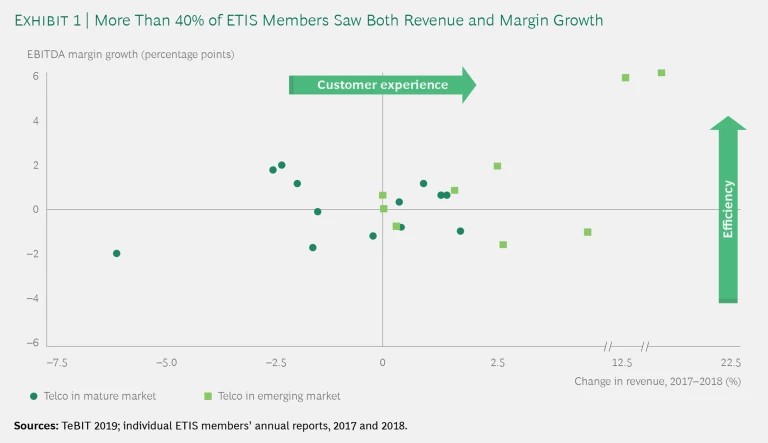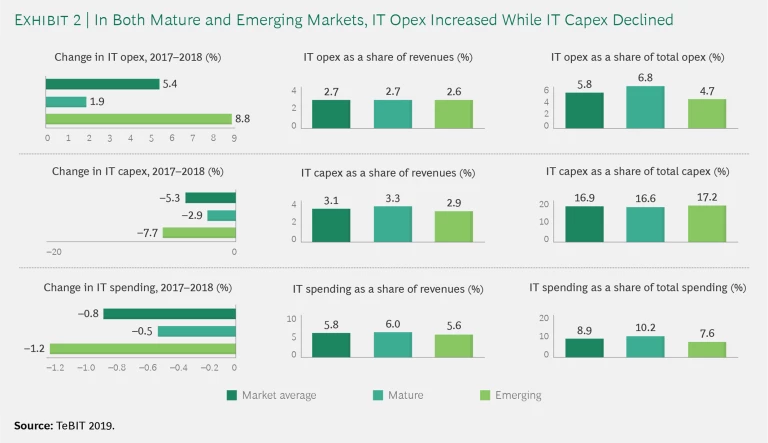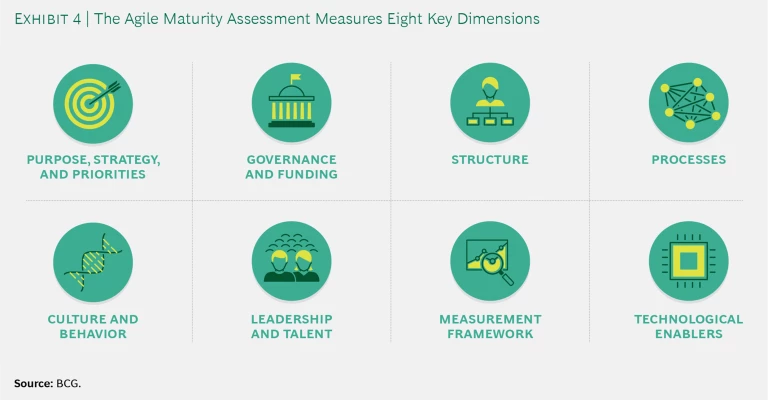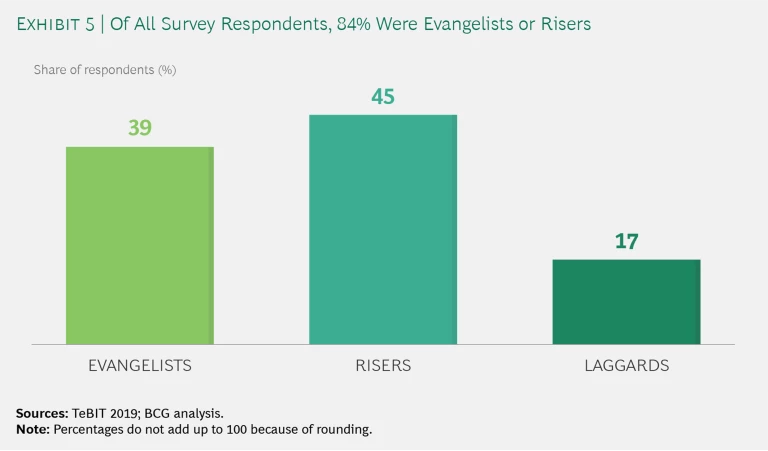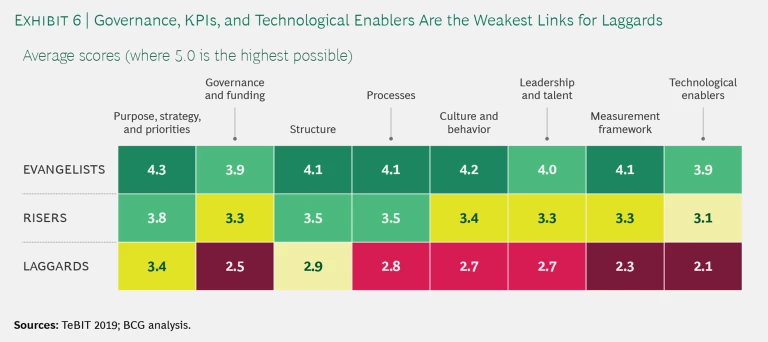Telcos and agile are a natural and necessary fit. Few industries, if any, are as rapidly shifting as the telecom business. And few methodologies, if any, are as responsive to change as agile. To be sure, more operators are taking more steps to implement this new way of working. But how’s the transformation coming? That’s the question explored in this year’s IT benchmarking study (TeBIT), a survey of European operators’ IT spending and performance that was completed in September 2019. The idea is to take a page from one of agile’s core pillars, the feedback loop, which requires that companies examine the work in progress, identify adjustments, make the changes, and iterate. TeBIT gets the loop started by looking at agile implementations and suggesting areas for improvement. Among them: developing more consistent measurement frameworks and deploying additional technological enablers. But it’s up to telcos to keep the iterations—and the momentum—going. And to, step by step, get to the optimal form of agile.
Agile has been a game changer in a growing list of industries. Companies often see a two- to fourfold acceleration in time to market, a three- to fourfold improvement in customer satisfaction, and a 15% to 25% reduction in development costs—among other benefits. Telcos are stepping up their agile game, adding talent and tools. But they have yet to commit fully to the new methodologies.
- All TeBIT participants are boosting their ranks of agile workers: the average year-over-year increase was 207%. Telcos are increasing their number of agile certificates, and tools that facilitate agile—like Gitlab, Jira, and Slack—are becoming more commonplace.
- But so far, agile is limited largely to telco R&D departments. And relatively few employees work fully in these methodologies. This is in contrast to the broader and deeper agile practiced by many of the tech companies that now compete against telcos.
Telecom operators are also proving to be agile in another sense: their business models are increasingly nimble. On average, this year's TeBIT participants generated nearly a third of their 2018 revenues from nontraditional sources, such as information and communications technology (ICT) and digital offerings.
- Roughly 40% of ETIS members were able to increase both their revenues and their EBITDA margin in 2018. That’s up from 23% in last year’s study.
- Although IT spending remained stable between 2017 and 2018, we detected a noticeable shift in the way that telecom operators spend their money. IT capex declined 5.3% while IT opex rose 5.4%. This is exactly what we would expect with a move to cloud-based systems and their usage-based payment models.
Telecom operators struggled when asked to share metrics that are commonly used in other industries to gauge—and adjust—the output of agile. Instead of using a standard set of KPIs, telcos tend to measure on an ad hoc team-by-team basis. Without KPIs, the feedback loop doesn’t work and the fruits of agile never fully ripen.
- The majority of TeBIT participants were unable to provide the number of defects, both before and after release. Half of the telecom operators could not offer data on product owner satisfaction or on the acceptance ratio for user stories (an agile metric that tracks whether a team’s output meets expectations).
- Inconsistent or absent KPIs make it difficult to understand the root causes of bad results and then adjust in the next iteration. Companies get to a solution, but they are less likely to get to the optimal solution—or get to it in the optimal amount of time.
As part of this year’s TeBIT study, a few hundred telecom employees completed a survey assessing eight dimensions of agile maturity. The results show that those working in agile tend to have a good understanding of the mechanics. But the survey reinforces concerns about measurement frameworks and fragmentation.
- Only half of the survey respondents work in agile at least 75% of the time. And telcos still seem to rely on traditional funding and management structures, instead of approaches better suited to agile.
- Many of the survey respondents gave low scores when it came to leveraging the technological enablers of agile—such as continuous delivery, automated testing, and modular architectur
Telcos seem to be holding their own compared with the agile maturity levels across other industries. But within individual telcos, we saw big differences between agile evangelists and laggards.
- Agile evangelists, who score well above the global means for the eight dimensions, accounted for 39% of all respondents. Risers, who score around the means, made up 45% of the survey sample. And laggards, who score well below cross-industry means, accounted for 17%.
- The measurement framework appears to be the most important variable in differentiating the three clusters. Evangelists scored 18% higher than the global mean in this area—while laggards scored 33% below it.
- Both risers and laggards turned in their lowest scores in governance and funding, measurement framework, and technological enablers. For telcos looking to increase their evangelist ranks, these are three key areas for focus.
Agile is a transformation that telcos need to get right. While operators are checking off some key boxes, they need to spur things along further. The best way to do that: the feedback loop. Assess, tweak, iterate—and drive incremental improvement.
- The core principles of agile can be applied to a wide variety of business activities. Why stop at R&D? With the right tweaks, agile’s benefits can be realized far beyond the lab.
- Agile isn’t something a telco simply plugs in. It requires both technical and cultural foundations. Coaching and talent management are as essential as platforms, tools, and architectures.
- Telcos must be vigilant in tracking team-specific KPIs. But they also need to find ways to measure agile’s overall impact. One idea is to focus on ultimate business outcomes, such as customer satisfaction and loyalty scores. Consistently—and continuously—applied, a measurement framework lets telcos evaluate and improve agile-based work.
Finding the Formula for Agile
Agile methodologies have earned their keep—just ask the digital companies that have mastered them. Within three years (sometimes far sooner), a smartly implemented agile transformation can spark a two- to fourfold acceleration in time to market, a three- to fourfold improvement in customer satisfaction, and a 15% to 25% reduction in development costs—all while enhancing productivity and employee engagement. Many digital players are reaping the rewards. Are telecom operators?
The agile way of working is just what telcos need—and need to do well.
It’s a critical question. Many telcos continue to face revenue stagnation or outright declines. Competition remains fierce (often coming from those very same digital players), as does pressure on costs and prices. Telcos are also battling to develop, and succeed with, new offerings and business models ahead of their competitors. By fostering collaboration, adaptability, and speed, agile helps companies respond better and faster to evolving trends. To put it simply, the agile way of working is just what telcos need. And need to do well.
This year’s telco IT benchmarking study—a survey of European operators’ IT spending and performance that was completed in September 2019—finds that participants are not quite there yet. To be sure, telcos are increasing their momentum when it comes to agile, and they seem to be doing many things right. But overall, TeBIT participants are taking a fragmented approach to agile. The methodologies are confined largely to R&D departments, and even there, relatively few employees are working fully in agile.
The survey’s deep dive into agile also revealed room for improvement in areas like governance, leadership and talent, and the use of technological enablers to facilitate agile processes and practices. But even more worrisome, perhaps: telcos seem to be having trouble assessing the impact of agile. They haven’t hit on a standard set of KPIs for measuring success.
Metrics are important, not only because they let you gauge how things are going but because they can show you where and how to make adjustments. The idea of a course correction—and telcos’ difficulty in leveraging the right metrics to do it well—was a big theme, and concern, in last year’s TeBIT report . There, we found that telcos were prioritizing their digital transformations yet lacked sufficient visibility into how their efforts were progressing.
With agile, visibility is just as vital. Agile is all about reacting quickly and decisively to change: in customer preferences, available technologies, and the competitive landscape. Few industries are as fast changing as telecommunications —making the need to embrace, and master, agile all the more pressing. Yet without the ability to see how agile is working and how it might work better, telcos won’t be able to react and innovate as quickly as they could. Or as quickly as those digital players they’re up against already can.
Telcos are on the right track, putting more emphasis and resources into their agile transformations. But they must redouble their efforts, taking a focused approach instead of a fragmented one and deploying agile and its enablers more broadly across the organization. They need that better visibility, too, in order to see how agile processes are connected to results—and how to make that connection stronger.
Changes in How—but Not How Much—Telcos Spend on IT
European telecom operators are increasingly agile, in both senses of the word. They are adopting agile ways of working but are also proving nimble in their business models. On average, TeBIT participants generated nearly a third of their 2018 revenues (31%) via nontraditional streams, such as information and communications technology (ICT) and digital offerings. In last year’s study, just a quarter of revenues came from these newer sources. The uptick was welcome. In a market where traditional fixed and mobile offerings are often commoditized and under price pressure, moving up means branching out.
That message seems to be getting around. Looking at ETIS members as a whole, we found that roughly 40% were able to increase both revenues and EBITDA margin in 2018. (See Exhibit 1.) Improving these metrics simultaneously has never been easy for telcos. In last year’s study, we found that only 23% of operators were able to pull off the feat. As we noted then, digital initiatives and businesses help by improving both the customer experience (which can boost revenues) and efficiency (which can boost margins). Telcos seem to be getting that message as well.
Indeed, after asking TeBIT participants to tell us their top three IT initiatives (by share of IT capex) and comparing their answers, we saw that customer experience projects and back-end software renewals (such as for billing) ranked highly overall. Both these areas support digitization and adjustments in the business model.
Across participants, IT spending barely moved the needle between 2017 and 2018, dropping just 0.8%. But that stability masks a noteworthy trend: a shift from IT capex to IT opex. On average, IT capex declined 5.3% while IT opex rose 5.4%. (See Exhibit 2.) This is exactly what we’d expect to see with a move to cloud-based systems—both for software and for IT infrastructure—and their usage-based payment models.
We also can posit a theory for the uptick in outsourcing, which accounted for 38% of total IT spending, compared with 24% in last year’s report. New technologies—in areas like AI, data and analytics, and robotic process automation—along with the shift in business models have heightened the need for new skills. But telcos often have difficulty recruiting the necessary talent. Outsourcing can be an efficient means of filling in the gaps.
A number that didn’t see an increase but maybe should have: IT spending as a percentage of revenues. At 5.8%, the figure was down just slightly from last year. As such, it’s worth noting the caution we sounded in our previous report—outside the telecom industry, many technology-driven companies prioritize IT spending even more. Last year, we asked if telcos are spending enough on IT. It’s a question we need to ask again.
To be sure, robust IT spending is essential for sparking and delivering the kind of innovation that can set an operator apart—not just from other telcos but from all the new entrants now on the scene. But if TeBIT results reinforce one key principle each year, it’s that how you spend the money also matters. Telcos are on the right track by investing in IT that improves the customer experience, supports new paths to revenue, and drives efficiency. And hitting that trifecta has never been more crucial.
Part-Time Agile
For telcos, agile can be a differentiator: a way to quickly get new capabilities—and innovation—in front of customers. And as the TeBIT study reveals, telcos are ramping up their embrace of these methodologies. But the data shows that, overall, telcos are taking a fragmented rather than a focused approach to agile, not fully committing themselves or their employees to the new paradigm. They also seem to lack sufficient visibility into agile’s impact. These findings raise some alarms because without focus and visibility, telcos risk ending up with a watered-down version of agile: one that brings benefits but never unleashes its full power.
Agile’s processes and potential aren’t a secret. (See “Agile: Your Rapid Response Team.”) But what has been less clear is how telcos are approaching their agile transformations and what kind of results—and challenges—they’re seeing. To gain insight into these areas, this year’s TeBIT study took a two-pronged approach: looking at agile from both the management and the employee perspectives.
AGILE: Your Rapid Response Team
AGILE: Your Rapid Response Team
Agile isn’t a single, set-in-stone framework but rather a set of principles—most famously laid out in 2001 by the Agile Manifesto—for working in ways that stress collaboration, flexibility, responsiveness, and continual improvement. The idea is that companies, indeed all organizations, that work in an agile way can adapt faster and better to change.
So what are those pillars of agile? First, agile breaks down silos. It brings together the various skills and expertise that are needed to build a product or solve a problem and leverages the collective knowledge. It also stresses an incremental path to a solution. In fast and frequent cycles, team members develop a bit more of the solution, solicit feedback, analyze what’s working and what’s not, and incorporate their findings into the next iteration. Agile makes it simple to adjust as you go, avoiding the costly rework—or customer dissatisfaction—that results when an end product doesn’t meet expectations.
If agile has been rising in the polls, that’s because the benefits it brings—faster time to market, adaptability to shifts and trends, and solutions more closely aligned with customer requirements—have never been more important. Little wonder, then, that it’s never been more essential to get agile right.
For the first part of the study, we asked participating telcos for some numbers on their agile transformations. Among them: how many employees are working fully in agile; how many are working partially in agile; how many agile coaches, certified scrum masters, and product owners they count. We also asked for metrics intended to gauge the quality of agile deliverables: the number of defects recorded during development and after release; the product owner satisfaction rate; the acceptance ratio for user stories (an agile metric that tracks whether a team’s output meets expectations). We looked at how all these numbers changed over time and what they might tell us about trends and, perhaps, concerns.
First the trends. Our assessment shows that all TeBIT participants are stepping up their game. The ranks of agile workers are growing—in some cases, dramatically. One telco saw an 820% increase in its internal agile-ready workforce. Across all participants, the average was 207%. Agile certificates are on the rise too. And specific tools (like Jira, Slack, and GitLab) are gaining traction.
But we also saw that this growth comes with caveats. For one thing, agile is limited largely to telco R&D departments. In areas such as sales, business operations, and customer service, the methodologies have not made significant inroads. (See Exhibit 3.) This isn’t really surprising, given that agile got its start in software development. But beyond the telecom industry, many agile-proficient companies—like those digital players that telcos are increasingly going up against—are extending agile’s reach outside R&D . So there is precedent, and perhaps some urgency, for implementing agile more broadly.
We also saw that telcos are applying agile in a fragmented way. Initiatives tend to be comparatively small pilot projects. More concerning is that many employees seem to be just dabbling in agile—not fully immersed in its methods. Half of the participating telcos reported employees who work in a hybrid model, following the new methodologies part of the time but sticking to the more traditional waterfall model the rest of the time.
Some argue that telcos run risks by taking this hybrid approach; that it creates waste and inefficiency in a model intended to reduce waste and inefficiency. (See “From a Small Step to a Giant Leap.”) There’s also concern that employees’ transition to agile—no simple matter under the best of circumstances—is harder when they are effectively carrying two roles, agile worker and nonagile worker, each with its own responsibilities, routines, and practices.
FROM A SMALL STEP TO A GIANT LEAP
FROM A SMALL STEP TO A GIANT LEAP
Agile is all about the methodology: the practices and principles that help a company work faster and better. But what’s the methodology for moving to agile? Telecom operators are taking different routes, but one thing is clear: no one’s found a silver bullet. How do you ease the transition for employees? How do you scale your agile pilots? And crucially: How do you measure success? Telcos may not yet have textbook answers, but they are gaining some insights. For a window into the dos and don’ts, BCG and ETIS spoke with Mads Bech Winther, agile strategy consultant at TDC.
TDC seems to have undertaken a fairly comprehensive agile transformation, covering sizable parts of the company. What’s the reasoning behind this strong embrace?
When you look into the future, you can just see that you need to be faster. Telcos traditionally operate a bit slowly, but this is a fast-moving market. You need to be more customer-centric, adapt quickly to new demands, innovate more. So out of that concern, TDC decided to do a pilot, called the Digital Warehouse, that would combine people from the business and IT. And from that pilot, it just scaled. I’d add that this is why benchmarking can be challenging. By starting small and scaling, we’ve only recently reached the point where agile is a dominant thing in some business areas. When you’re in more of a pilot stage, you may be working in agile, but you’re still measuring in a more traditional sense. But you need different measurements and KPIs to truly gauge agile’s impact.
We saw that telecom operators have been struggling to define a standard set of KPIs. Instead, they tend to measure success on an agile-team-by-agile-team basis. What’s been your experience?
The same. There’s a school of thought that almost all measurements induce some kind of command and control, and because you’d rather induce trust, you should just measure with your own eyes to ensure quality. I don’t know that I share that view. While the trust model is important, you do need baseline measurements. The catch is, those measurements should be owned by the team—or as we refer to it, squad—and used by just that squad because each squad is self-organizing and works on different things.
Any other learning from your agile initiatives?
One thing we’ve discovered—and this is going to sound like a paradox—is that you need a rigid structure before you can get the flexibility you want. What do I mean by that? Consider the online brands that TDC has acquired over time. From their start, they’ve worked in agile. And if you go into their IT departments, you’ll see that they have their own agile systems and those systems just function. But in every case, they started with scrum—a specific framework for agile.
I think that’s a huge point, to be disciplined first, introducing something like scrum, where you have a rigid structure. Then you can take the learnings you’ve developed and move into a more customized form of agile that fits better with—and is more effective for—your particular environment.
If you look at TDC’s four agile tribes, they correspond to new companies and business units, like Nuuday and YouSee. What was the rationale for separating your agile transformation in this way?
In one sense, this is just how we’re structured now. We have new owners, and TDC has been split up into separate companies. But I also think that agile fits really well with the business models you want in a company like Nuuday, where you’re operating more like a mobile virtual network operator and you have to be really customer centric. It’s also worth noting that in a big company like TDC, there’s a certain formality in how you implement agile. It’s very different from a startup that can simply begin with agile. You have to do a proper pilot. You have to get funding. You have the old hierarchy, the old systems, the silos. So if you want an agile setup, you basically have to box it in and say, “Okay, we’re working in agile over here.” And the goal is, you’ll scale. It’s difficult. In a sense, you’re throwing some agile squads on the bottom of that hierarchy and hoping they’ll fight their way out.
Are you already seeing tangible benefits from agile?
I don’t know if you would call this tangible, but one benefit—and it’s a very important one for us—is that agile just makes for a happier way to work.
“With agile it's easier to empower employees to say 'Let's innovate.' There are fewer people to convince and hoops to jump through before you can get started.”
You definitely see this, especially if you talk to people working in IT. Agile’s other great benefit is the platform it provides for talking about, and accelerating, innovation. Before agile, you really couldn’t just come in and say, “Let’s innovate.” There were always people to convince and hoops to jump through before you could even get started.
The number of employees working in agile at TDC nearly doubled in the past year. That’s a lot of people to onboard, train, and integrate. How do you manage this growth?
We have a strong focus on coaching. You need people to guide the process: scrum master, agile coaches. It’s vital because when people start with agile, even if they know the benefits of collaboration, they’ll still tend to close themselves around their work. You’ll see this especially with those who work in user experience or user interface design. They’re really artists, used to doing their own work in their own way. So you need to constantly remind people to open up, to collaborate. I think this is a universal challenge with agile, and you need to address it from the beginning through coaching. You mentioned our agile workforce doubling, and if you do this benchmark next year, I think you’ll see it double again. But one caveat—and I think this is true for all companies—is that sometimes it’s hard to get an accurate count of who is truly working in agile. You may have a product owner who is essentially still working as a product manager. That’s why coaching is so important. You really need to educate and train people in agile, so they have the processes as well as the title.
Many companies struggle with how to incentivize employees to make the transition to agile. How do you ease the journey?
First off, I think you need to recognize that agile is not for everyone. I see all the young people who know that this is how they want to work. But if I went to some of the people who work with the legacy stuff and with the infrastructure, I could imagine them having real reluctance. I’ve also seen some scrum masters giving up after a year and a half and just going back. We’ve been very good about saying, “Okay, you can rotate somewhere else.” You need to be empathetic and understand their situation. But I also think the transition can be especially challenging when people hold two roles; for example, becoming a product owner but still acting as a more traditional manager.
That raises an interesting point. TDC’s agile fragmentation—the percentage of people working part of the time in agile—was very low compared with other European telcos. People tend to work in either agile or waterfall, not both. Do you feel that having pure agile teams makes a difference?
I think it makes a huge difference. If you’re spending half your time in agile and half in waterfall, it’s not like you’re splitting your potential 50-50. There’s going to be so much waste, in terms of efficiency and effectiveness, that you’re more likely delivering 25-25. I’m very much against fragmentation. In my opinion, the waterfall system does not support or excite commitment and ownership as well as agile.

Another issue is the visibility challenge—or perhaps more accurately, deficit. Overall, telcos struggled when asked to share metrics that are commonly, and continually, tracked in other industries. The majority of TeBIT participants were unable to provide the number of defects, both before and after release. Half the telcos could not report data on acceptance ratio and product owner satisfaction. Indeed, when it comes to agile KPIs, the general trend is to forgo a standard set of metrics, consistently applied, in favor of measuring on an ad hoc team-by-team basis.
The problem is, metrics are especially important for effectively implementing agile. One core tenet of agile is that it’s a self-learning process. You develop a solution in short, frequent cycles, each time looking to KPIs—like those mentioned above—to understand the root causes of bad results and adjust accordingly in the next iteration. Step by step, you don’t just get to a solution but get to the best solution. Without KPIs, the feedback loop doesn’t work and success becomes much more random.
Inconsistency in measurement also makes it difficult to get an overall perspective on agile’s impact: how it affects costs, productivity, quality, and customer satisfaction. And without that perspective, it can be harder to make the case for extending agile further, and deeper, into the organization.
Of course, agile isn’t just about numbers. It’s also about culture and mindset and all the enablers—whether people, processes, or technologies—of an agile way of working. For insight on that perspective and where telcos stand, we surveyed those who actually work in agile: the telco employees. As we’ll see in the next chapter, this second prong of our analysis also reveals where telcos are hitting the right notes—and where they need to hit a little harder.
Agile is a self-learning process—step by step, you don’t just get to a solution but get to the best solution.
The Employee Perspective
For a boots-on-the-ground view of agile, this year’s TeBIT study relied on a self-assessment completed by a few hundred telecom professionals. (See Exhibit 4.) Covering eight dimensions of agile maturity, this survey did double duty. It enabled us to take the pulse of agile within participating telcos and provided a sense of how telecom operators compare with other industries implementing agile. It turns out, telcos are holding their own. But they still have work to do in areas like governance, measurement frameworks, and technological enablers.
The assessment finds that, overall, telco employees have a good handle on agile’s mechanics. They understand and employ agile’s core concepts and practices, such as daily standups, minimum viable products, incremental development, frequent feedback, and collocation of team members. They also tend to have a good understanding of their telco’s purpose, strategy, and priorities—and how their own work fits into that.
But at the same time, the survey results reinforce—and even make starker—the concerns that we had after analyzing the management-provided data. Fragmentation is less a trend than a standard: only half of respondents work in agile at least 75% of the time. And few agile workers can be found outside R&D. Tellingly, many respondents gave low scores when it came to two key assessment dimensions: measuring agile’s output and leveraging the tools, platforms, and architectures that facilitate an agile way of working (such as continuous delivery, automated testing, application programming interfaces, and modular architecture). Indeed, the survey responses strongly suggest that European telcos have yet to fully—or even sufficiently—deploy technological enablers.
We also see that telcos still seem to rely on traditional funding and management structures. For example, they tend to use older processes for evaluating employees and allocating resources. Although such practices may have served telcos well in the past, an agile way of working calls for new approaches to governance and funding, as well as talent management. (See “The Long Arm of Agile.”)
THE LONG ARM OF AGILE
THE LONG ARM OF AGILE
Agile has its roots in software development and to judge from this year’s TeBIT study, it has largely stayed put: telcos are applying the methodologies almost exclusively in R&D. But some operators are starting to branch out—or at least looking to apply agile’s principles in other parts of their business. For thoughts on how, and where, telcos can extend agile’s reach, we spoke with Geert Goethals, chief information officer at Proximus Group.
Proximus launched its #shifttodigital strategy in early 2019. How does agile fit with your plans?
Agile is a crucial part of our shift-to-digital strategy. Internally, we have created nine strategic objectives, and one of them is changing the way we work. What’s important to note is the breadth we envision for agile. Of course, you want to deploy it in product development so you can build things that are much more connected to customers’ needs and get to market faster. But we also see a lot of opportunity—and value—in applying agile principles to other areas of the company. We want to see how we can bring these concepts into pure operations and into the day-to-day activities of our business units.
So agile is more a guiding principle than a strict interpretation of a specific methodology?
Indeed. Our thinking is, let’s adhere as much as possible to the concepts behind agile but see what is the best way to implement them for different types of activities—or as we call them, archetypes—across the organization.
You mentioned that a new way of working is one of Proximus’s strategic objectives. Can you elaborate on your motives and the benefits you expect?
The underlying thinking is to move to an empowered organization, one where we can get more out of the collective competence and capacity of people. There are many potential benefits you can attach to this, but I’d put a few at the top of our list. We want to ensure that we can keep up with the pace of our world. We want to make sure that what we put together is much more connected to customer expectations. Finally, there is the efficiency bonus. In the traditional way of working, you’re building things in a much more monolithic way, so it’s hard to make changes as you go along. Ultimately, there is a lot of rework—and a lot of costs, in time, resources, effort. Agile is about avoiding that.
Can you give us an example of where you are already seeing these benefits?
I think there are two or three very good examples. First, there is everything that has to do with what we call the digital factory—all of the activity around the MyProximus site and our mobile application, for instance. We’ve integrated business and technical teams, and I think the payoff can be seen in customer satisfaction. Another example is around our content offer, where we’ve also moved to a much more integrated model. And this is really the crucial component: bringing together the business people and the technical people and unleashing collaboration and collective knowledge. But you have to think hard about roles—like the product owner—and who will fill them.
Have you experienced any challenges?
It’s interesting because this brings me to another successful example I can give you: the transformation of our professional market IT. It’s a success because we are bringing greater agility into our execution. But it’s also a challenge because it touches so many things: the digital environment, the selling system, the ordering system, the provisioning system. When you touch a lot of things, you’ll likely need to move some traditional teams to agile in order to get the full benefits. And not all teams are equally advanced in terms of, say, continuous integration and continuous deployment. So there’s definitely a challenge in bringing everybody onboard. In our case, it’s evolving well, but I think this really points to something all telcos will face as they try to broaden agile’s reach. And of course, you should never underestimate the cultural change that goes with the new ways of working.
Indeed, other telcos have told us about the resistance they’ve faced. How do you ease the transition for employees?
The most effective thing we do is to have very extensive change management as we onboard the different teams. But one thing we’ve discovered is that within the teams, you’ll get a momentum that drives adoption.
“The underlying thinking is to move to an empowered organization, one where we can get more out of the collective competence and capacity of people.”
You’ll have a critical mass of people that are very much into agile and let the rest of the community know it. Whenever there is change, there is bound to be doubt, but I have yet to meet someone who says, “You know, this agile way is not good, it’s not effective, it’s not more fun than a traditional way of working.” That’s very motivating. So I think the key is, don’t try to make everyone agile at the same time but have these good examples that create a positive momentum.
Telcos have also told us that the shift to agile requires completely different skills or at least a different mindset. How do you approach this challenge—and how successful do you feel you’ve been?
Training is important and so is coaching. But as you say, it’s also about mindset. Does your culture incentivize the right mindset? Two or three years ago, we started a cultural transformation that focuses on how to manage and perform in a way that is more compatible with agile. One element we’ve especially focused on is accountability, something you really need to address when moving from a traditional command-and-control model. As a leader, you need to behave differently to stimulate accountability in people. You need to understand the things you want to promote, the things you want to incentivize, the practical dos and don’ts. Our program has certainly made an impact. But this is something you need to work on continually.
Proximus plans to hire more than 1,000 people in the next couple of years. Will they be integrated into an agile way of working? And how will you manage the growth in agile employees?
Without doubt, most of our new hires will be integrated into teams that are becoming much more agile. So on one hand, we’re looking to hire people who have the skills we need—say, in areas like data, analytics, and security. But we’re also looking for something else in those new hires: the ability to integrate well with the new way of working. This always makes me think of something Netflix says: on a dream team, there are no brilliant jerks. It’s crucial that the people we hire fit in a team-oriented, accountability-oriented way of working. Otherwise, agile is never going to bring the value that we expect.
Another challenge involves KPIs. The TeBIT study finds that, overall, telcos struggle with measuring agile’s success. What’s your approach?
We can confirm that it is difficult. The idea is to take those benefits I mentioned and ask how they translate into measurable things. But the answers are not straightforward. Consider time to market. What does that mean for agile, where you have a more phased delivery? My view is, if you really want to measure success you should do it as close as possible to what ultimately matters to the business or to the customer. Have customer satisfaction and your Net Promoter Score changed? You need to look as much as possible at the ultimate outcomes.
We also saw that employees can be grouped into three clusters: agile evangelists, laggards, and risers. A key factor determining why someone fell into the laggards’ group was their use of technological enablers. How does Proximus ensure that all employees have the tools to succeed with agile?
There are really two components to this. First you have what I call the hard product: your technical enablers, the tools you need to put in place if you want to move to things like continuous integration and continuous deployment and DevOps. So, of course, we’re creating these technology foundations. But we’re also focused on the soft product, and by that I mean training and especially coaching. We’ve created an agile center of excellence, which manages a pool of agile coaches. These coaches will work very closely with a team and can really drive adoption. Indeed, good coaching is a very effective means for moving people through the transformation.
Looking ahead and across the company, where do you think agile will have the biggest impact?
We very much believe that agile can be applied to many areas within the company. I think the starting point is to look at activities where integration and interaction between different stakeholders is crucial. Obviously, product development fits the bill. But so can pure operational activities. For example, look at how you resolve customer-specific issues. Traditionally, you have separate groups: first-line customer operations, second-line customer operations, IT. And you’d flow a problem from one group to another. We created an integrated team, and this really brought a lot of value, letting us more efficiently get to the solution. We definitely see agile having an impact beyond pure product development, in different archetypes of activity across the company, though we may need to implement slightly different flavors of agile.

Notably, the maturity assessment found few differences between individual telcos: for the most part, TeBIT participants are doing the same things right (such as promoting their purpose and strategy) while struggling with similar challenges (like making effective use of technological enablers). But in today’s competitive environment, where lines between industries are often blurred, telcos are not just up against one another. So it’s important to know how their agile initiatives fare on a more global scale; how they stack up against the agile that other industries practice.
From the survey answers, we identified three groups of respondents: agile evangelists, who score well above the global means for the eight dimensions; risers, who score around the means; and laggards, who score well below the means. The breakdown finds telcos holding their own. More than a third of the survey respondents—39%—were deemed evangelists, with 45% falling into the riser group, and just 17% categorized as laggards. (See Exhibit 5.)
A closer analysis reveals some interesting patterns. For example, the measurement framework appears to be the most important variable in differentiating the three clusters. Evangelists scored 18% higher than the global mean in this area, yet laggards scored 33% lower than the global mean. Evangelists also seem to be making good use of technological enablers—not only compared with risers and laggards but also compared with agile workers in other industries, notching a mean score of 3.89 versus a global mean of 3.26 (on our 5.0-point scale).
At the other end of the spectrum, laggards especially earned their label in three areas: governance and funding, the measurement framework, and technological enablers, turning in average scores of 2.5, 2.3, and 2.1, respectively. (See Exhibit 6.) And while risers fared significantly better (scoring 3.3, 3.3, and 3.1, respectively), these were their lowest-ranked areas as well (risers also turned in a 3.3 for leadership and talent). To be sure, telcos have to do more to create—and unleash—all-evangelist teams. But they now have their focal points.
Moving the Dial on Agile
For telcos, agile is not just another framework to learn and apply. It is a transformation. And there’s a lot riding on getting this transformation right. Telcos that work well with agile methodologies can respond faster, and better, in a rapidly changing market. Yet to get the most out of agile, they need to commit to it, facilitate it, endorse it, and—not least of all—keep a sharp eye on it. This year’s TeBIT study finds that telcos have some work to do on those fronts. And until they close the gaps, they may not reap the full benefits that agile can bring.
Until they close the gaps in their approach to agile, telcos may not reap its full benefits.
To be sure, telcos are checking off some key boxes. Overall, implementations are in line with other industries, with the majority of TeBIT participants matching—or even exceeding—cross-industry averages for agile maturity. Employees working in agile seem to have a good impression of it too. Word of mouth has proved a potent means of driving adoption. So has the power of example. Success stories are spurring more initiatives—and spurring more employees to join the agile ranks. (See “Agile’s Ripple Effect.”)
AGILE’S RIPPLE EFFECT
AGILE’S RIPPLE EFFECT
To what extent is a shift to agile part of Altice’s digital transformation?
Agile is a key pillar of our digital transformation. And we’re already seeing the benefits. Consider, for example, our interactive TV service, which is steadily gaining market share. The quality of our TV experience is largely the result of software features developed via agile practices. In the past, we’d have a new release every four months. Now, because of agile, we can do it every three weeks. So we’re delivering a lot of features, a lot of functionality, quickly and frequently. And that really adds value to our service. Indeed, everything we are doing in digital—like our customer and mobile portals—is coming via agile. It’s really helping us to provide the best solutions to our customers.
From the TeBIT data, we see that telcos are primarily implementing agile within their R&D departments. What is Altice’s view on broadening agile’s reach?
We have several agile teams, and, of course, R&D is a focal point for the methodology. But we also are using agile within our network operations center, or NOC. This is a great example of the power of agile outside R&D. In the NOC, you really want to increase automation. But automating the NOC procedures is such a vast and challenging task that only an incremental and collaborative approach could work. Agile is perfect for that. It has completely transformed the way the NOC team works, and the automation is growing, growing, growing.
“Our approach is to show the results from the agile teams—to show successful change—and get people curious and interested.”
As a result, we’re seeing this great effect where the people working in the NOC are becoming evangelists for agile. And that’s fantastic for the organization because it lets us build upon the achievements and the enthusiasm for agile to transform other teams.
That’s something we’ve heard from other telcos, as well: that when it comes to promoting agile within the organization, it’s more effective to show than to tell.
Exactly. I remember asking people on the teams how they felt about agile and they’d say, “It’s so much better, we have so much productivity, and it is really so much fun to work in this methodology.” And you can see it: they don’t want to go back. That’s really powerful when you’re trying to move other teams to agile. And you need to move those other teams. You need agile for development work. You need agile for all the things you want to automate: the NOC, service provisioning, and so on. But another important point is 5G. Software plays a big role in 5G, and for software, you need agile. Keep in mind, too, that your partners—even the traditional vendors—are also pushing for agile. For example, on the mobile core, the vendors we use are moving to incremental releases, instead of doing, say, a major release every year. So for testing and deploying the related features on the network, we need to adopt agile as well.
You mentioned that you’re already seeing benefits from agile. Let’s talk about measuring agile’s success. In the TeBIT study, we found that telcos are struggling to define overall KPIs. Instead, they tend to measure success on a team-by-team basis. What is Altice’s approach?
I think we are not different from the other telcos. Every agile team uses its own KPIs to measure the success of the team itself. And here they’ll use the typical KPIs: acceptance ratio for user stories, number of defects, product owner satisfaction. But at a global level, we will also look at our customer satisfaction scores. Of course, both agile and traditional methodologies impact those scores. But it’s what we have today. It’s also worth noting that you need to think about opportunity costs as well. If we don’t have the type of service people are asking for, we will lose customers. Agile is definitely helping us avoid opportunity costs, but this is very difficult to measure.
Going into your digital transformation, did you expect agile to play such an important role?
No, in fact, when we started our transformation we focused mainly on technology: software-defined networking, virtualization, cloud-native technologies, and so on. The idea was, let’s get everyone trained on this new stuff, and that will take care of everything. But we found that you really can’t capitalize on the new technologies until you change the culture and change the mindset. We had strong expertise on our teams, but these teams were in silos. And we realized this would be an obstacle going forward. So we shifted our focus from technology to culture, to make sure that each of us had a digital mindset: open to new work methodologies; able to collaborate and break down the silos. Concepts like agile and DevOps thus became integral parts of our transformation program.
Cultural change is rarely easy—or seamless—and at many companies, there is resistance. How do you ease the transition to an all-new methodology?
Our approach is to show the results from the agile teams—to show successful change—and get people curious and interested. It takes time. You’re not going to have the entire organization adopt agile overnight. We also do internal workshops and invite experts to come talk about the advantages of agile, of scrum. We are promoting DevOpsDays Portugal. During lunch breaks, we sometimes have 45-minute seminars, where our agile team leaders talk about the way they are working and present their results. We are seeing increasing attendance at these talks, and you know how we Portuguese are about lunch—we like to sit down with a knife and fork and eat.
How do you make sure that every employee has the right tools to succeed in an agile world?
I think that providing the right tools and training is particularly important with agile. Each team member in TechOps not only needs traditional networking knowledge but also a new set of skills from IT: scripting; expertise in cloudification, virtual machines, containers, APIs, open-source tools, and so on. So we are delivering training in all of these areas. We did an assessment of every team to understand where everyone was at, and we provide courses to fill in any gaps. But we also know that training isn’t enough. Learning is a continuous process, and we have to keep providing information to people and challenging them to improve.

The challenge now is to push things along further. Or, as agile would have it, make it faster and better. The idea isn’t to completely change the way telcos implement the methodologies but to initiate a feedback loop and—in a very agile way—drive incremental improvement. A good place to start is with the weak spots, or yellow flags, revealed by the TeBIT study.
One focal point should be the breadth and depth of agile. Right now, telcos are using agile almost exclusively within R&D. It makes sense that they started there: it’s where agile is likely to be of the most immediate and obvious benefit. But it doesn’t make sense for telcos to stop there. Some forward-looking telcos are realizing—as many digital players have—that agile’s core principles can be applied to a wide variety of business activities. Methodologies may need some tweaks, but the general concepts and payoffs apply outside the lab too. It’s time to start applying them.
It’s time for telcos to ramp up their commitment to agile.
It’s also time to ramp up the commitment to agile. The fragmentation we see—the part-timer approach to agile methodologies—is easy to explain but hard to endorse. Fragmentation dampens the benefits of agile. And in hypercompetitive, hyperdynamic telecom markets, operators don’t have the luxury to bask in partial benefits. They need the full measure.
How to get it? A good place to start is to look at agile leaders outside the telecom industry. They’re applying agile to more and more parts of their business, and their teams go all in: agile isn’t another way of working but the only way of working. These companies do some other things as well. They stress coaching. They evangelize agile at—and from—the top levels of the organization . They provide tools that ease, enhance, and expedite the agile experience. They measure success, and failure, relentlessly. And they understand that agile isn’t something you just plug in—it requires a cultural transformation too.
More telcos need to follow this playbook. And those that have started need to ratchet up the momentum. At the top of the to-do list: boosting the use of technological enablers and developing stronger, more consistent measurement frameworks. Telcos need to be more vigilant in tracking team-specific KPIs, such as defects, and must find ways to measure agile’s overall success. For the latter, one idea is to focus less on the technical metrics and more on the ultimate business outcomes—like changes in customer satisfaction and Net Promoter Score.
The feedback loop is a major pillar of agile. The idea: you look at a work in progress, see what needs adjustment, implement the change, and repeat. A well-designed, well-executed feedback loop can get you to an optimal result quickly and efficiently. For telcos, agile is a work in progress. The TeBIT study suggests adjustments—now it’s time to iterate and implement. By doing so, telcos can get closer to their optimal result: realizing the full potential of agile.

